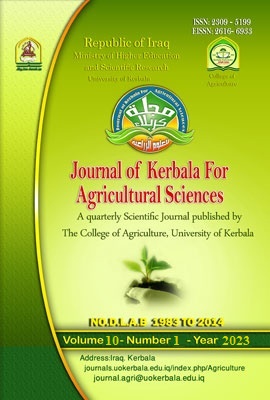¬Relationship of ACTN3-Promoter gene polymorphism and Alpha actin-3 concentration with performance of Original Arabian-WAHO horses
DOI:
https://doi.org/10.59658/jkas.v10i3.1125Keywords:
Original Arabian-WAHO horses, ACTN3/ Promoter, Alpha actin-3 conc., RegressionAbstract
The research was conducted in the Iraqi Equestrian Club (15 km west of Baghdad city center) for the period from 10/1/2021 to 11/30/2022, with the aim of detecting polymorphism in the ACTN3 gene (promoter region) in original Arabian horses (WAHO). There were two variants (2 SNPs) in the Promoter region, which are rs1150531051 with polymorphism of TT, TC and CC, and the frequency of the two alleles T and C amounted to 0.34 and 0.66), and the variant rs1144978872 with polymorphism of GG, GA and AA, and the frequency of the two alleles G and A amounted to 0.68 and 0.32. It was observed that there is a positive and significant regression of the depth of respiration after the exercises on the concentration of alpha-actin 3, and the regression of the number of respiration times after the exercises on alpha-actin-3 and the ratio of alpha-actin-3 to the RNA level is positive and significant and reached 0.905 and 0.569, and there is a positive and significant regression (P≤0.05) for the speed of horses on the concentration of α-actin 3 (0.552 m/min) as well as on the ratio of α-actin 3 to RNA level (0.617 m/min) in purebred Arabian horses. We can conclude, through studying the genetic features in the ACTN3 gene, the promoter region, that it can be adopted in setting strategies for genetic improvement in horses. The rates of velocity and the number of body dimensions increased with the increase in the concentration of actin, and some values of the coefficient of determination (R2) were moderate
Downloads
Published
How to Cite
Issue
Section
License
Copyright (c) 2023 Copyright (c) 2024 is the Author's article. Published by the Journal of Kerbala for Agricultural Sciences under a CC BY 4.0 license

This work is licensed under a Creative Commons Attribution 4.0 International License.
Licensing Terms
All articles are published under a Creative Commons License and will be directed to the Creative Commons Attribution 4.0 International License (CC BY 4.0) That permits use, distribution, and reproduction in any medium, provided the original work is properly cited. This license also allows the work to be used for commercial purposes.
Use by both non-commercial and commercial users
This content is licensed under a Creative Commons Attribution 4.0 International (CC BY 4.0) license, permitting use by both non-commercial and commercial users. Individual users may access, download, copy, display, and redistribute the articles to colleagues, as well as adapt, translate, and text- and data-mine the content, subject to the following conditions:
- The author's moral rights, including the right of attribution and the right to protect their work from derogatory treatment, are respected.
- Where content in the article is identified as belonging to a third party, users must ensure that any reuse complies with the copyright policies of the owner of that content.
- If the article content is reused for research or educational purposes, users should maintain a link to the appropriate bibliographic citation, including the DOI and a link to the published version on the journal's website.






